Quick Look
Grade Level: 6 (4-6)
Time Required: 30 minutes
Expendable Cost/Group: US $1.00
Group Size: 1
Activity Dependency: None
Subject Areas: Chemistry
NGSS Performance Expectations:

| 5-ESS2-1 |
Summary
Why do we care about air? Breathe in, breathe out, breathe in... most, if not all, humans do this automatically. Do we really know what is in the air we breathe? In this activity, students use M&M® candies to create pie graphs that show their understanding of the composition of air. They discuss why knowing this information is important to engineers and how engineers use this information to improve technology to better care for our planet.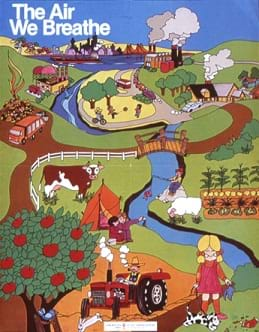
Engineering Connection
Environmental engineers must understand air composition to figure out what is causing poor air quality and how to clean it up. Improving air quality is a challenge because so many chemicals are reacting in the air at any given moment. Environmental engineers analyze and model these processes and design ways to improve air quality for the benefit of the Earth's inhabitants.
Learning Objectives
After this activity, students should be able to:
- Describe the major gaseous components of the atmosphere.
- Explain why engineers need to know the composition of air.
- Use a circle graph (pie chart) to describe and interpret the atmospheric composition.
- Explain relative sizes of fractions and percentages.
Educational Standards
Each TeachEngineering lesson or activity is correlated to one or more K-12 science,
technology, engineering or math (STEM) educational standards.
All 100,000+ K-12 STEM standards covered in TeachEngineering are collected, maintained and packaged by the Achievement Standards Network (ASN),
a project of D2L (www.achievementstandards.org).
In the ASN, standards are hierarchically structured: first by source; e.g., by state; within source by type; e.g., science or mathematics;
within type by subtype, then by grade, etc.
Each TeachEngineering lesson or activity is correlated to one or more K-12 science, technology, engineering or math (STEM) educational standards.
All 100,000+ K-12 STEM standards covered in TeachEngineering are collected, maintained and packaged by the Achievement Standards Network (ASN), a project of D2L (www.achievementstandards.org).
In the ASN, standards are hierarchically structured: first by source; e.g., by state; within source by type; e.g., science or mathematics; within type by subtype, then by grade, etc.
NGSS: Next Generation Science Standards - Science
| NGSS Performance Expectation | ||
|---|---|---|
|
5-ESS2-1. Develop a model using an example to describe ways the geosphere, biosphere, hydrosphere, and/or atmosphere interact. (Grade 5) Do you agree with this alignment? |
||
| Click to view other curriculum aligned to this Performance Expectation | ||
| This activity focuses on the following Three Dimensional Learning aspects of NGSS: | ||
| Science & Engineering Practices | Disciplinary Core Ideas | Crosscutting Concepts |
| Develop a model using an example to describe a scientific principle. Alignment agreement: | Earth's major systems are the geosphere (solid and molten rock, soil, and sediments), the hydrosphere (water and ice), the atmosphere (air), and the biosphere (living things, including humans). These systems interact in multiple ways to affect Earth's surface materials and processes. The ocean supports a variety of ecosystems and organisms, shapes landforms, and influences climate. Winds and clouds in the atmosphere interact with the landforms to determine patterns of weather. Alignment agreement: | A system can be described in terms of its components and their interactions. Alignment agreement: |
Common Core State Standards - Math
-
Find a percent of a quantity as a rate per 100 (e.g., 30% of a quantity means 30/100 times the quantity); solve problems involving finding the whole, given a part and the percent.
(Grade
6)
More Details
Do you agree with this alignment?
-
Understand the concept of a ratio and use ratio language to describe a ratio relationship between two quantities.
(Grade
6)
More Details
Do you agree with this alignment?
International Technology and Engineering Educators Association - Technology
-
Explain how knowledge gained from other content areas affects the development of technological products and systems.
(Grades
6 -
8)
More Details
Do you agree with this alignment?
State Standards
Colorado - Math
-
Use common fractions and percents to calculate parts of whole numbers in problem situations including comparisons of savings rates at different financial institutions
(Grade
6)
More Details
Do you agree with this alignment?
Colorado - Science
-
Identify evidence suggesting that atoms form into molecules with different properties than their components
(Grade
6)
More Details
Do you agree with this alignment?
-
Find and evaluate information from a variety of resources about molecules
(Grade
6)
More Details
Do you agree with this alignment?
Materials List
Each student needs:
- small bag of plain M&Ms® candies (or any other multi-color, equally-sized small candy or pieces)
- 8.5" x 11" blank sheet of paper
- colored pencils or markers
- (optional) small sandwich bags to organize the candies
Worksheets and Attachments
Visit [www.teachengineering.org/activities/view/cub_air_lesson01_activity1] to print or download.Introduction/Motivation
Background
Just imagine... The layer of air around the Earth is only about 10 miles (15 km) thick. This is like the thickness of a human hair placed on a globe that is 45 cm in diameter. Only the bottom 3 miles (5-6 km) of this layer contains enough oxygen for living organisms.
Air is incredible! It is generally invisible (we cannot see or smell it), but we can feel it (wind). It can carry small particles (dust, fog, smoke) and large objects (airplanes, kites, birds, frisbees). It travels all over the planet but does not leave the atmosphere (some of the air you are breathing right now has already been in the lungs of your classmates). See Figure 1, Table 1 and the attached Layers of the Atmosphere Reference Sheet.
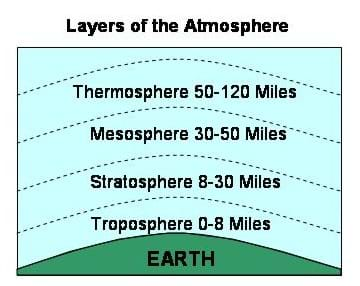
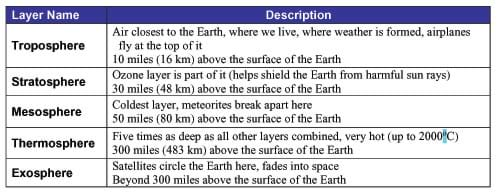
The Composition of Air
78% nitrogen (N2)
21% oxygen (O2), needed by most living things
0.9% argon (Ar)
0.1% is a mixture (neon [Ne], helium [He], methane [CH4], krypton [Kr], hydrogen [H2], nitrous oxide [N2O], xenon [Xe] and carbon dioxide [CO2]). Carbon dioxide is a colorless, tasteless and odorless gas, usually present at a concentration of 0.03% of the atmosphere.
Please see Figure 2 or the attached Air Composition Pie Graph Worksheet.
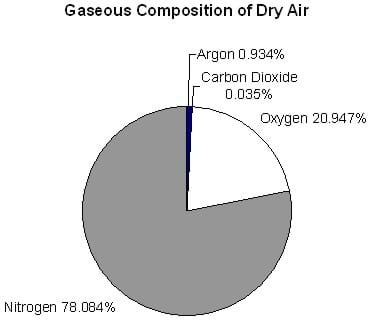
Why Engineers Care
Engineers continually monitor the components of air. It is important for them to know the components of air under normal (or base) conditions so that when they monitor levels of N2, O2, Ar, N2O, CO2 and other gasses, they can tell when the air is no longer at base conditions and may be harmful to humans and the environment. For instance, power plant emissions are always monitored for major deviations beyond that of normal air. In fact, many devices are built into power plants to decrease the levels of carbon dioxide and particulate matter that are released into the atmosphere. Engineers monitor the emissions to make sure these devices are working properly. Increased levels of carbon dioxide and methane, and decreased levels of oxygen are considered dangerous. With these factors in mind, engineers are continually working to monitor and improve the air on our planet.
Procedure
Before the Activity
- Gather materials (try not to eat the M&Ms!). Each student needs 7 brown, 2 red and 4 yellow M&Ms (if helps to use small sandwich bags to organize the candies).
- If needed, make copies of the How Much? Pre/Post Quiz (two per student), Layers of the Atmosphere Reference Sheet (for an overhead projector sheet or handout), and Air Composition Pie Graph Worksheet (suitable for grades 3-4 students).
With the Students
- Ask students: What is air? What is in air? From what components is air made? Take suggestions. Tell them they will find out more in this activity.
- Give each student a bag of M&Ms. Tell them NOT to eat the M&Ms (yet)!
- Explain that air is made up of many different things, and that each different colored M&M represents a different "ingredient."
- Have students sort their M&Ms by color (7 brown, 2 red and 4 yellow M&Ms). (Note: These colors are suggested based on the usual distribution of M&Ms in a bag. If students do not have enough for 7 of one color, have them trade with another student or open up another bag of M&Ms.)
- As shown in Figure 3, arrange 7 brown, 2 red, and 1 yellow M&Ms in a circle on a blank sheet of paper, with like colors together and the sides of the M&Ms touching. The extra yellow M&Ms will be used later.
- Trace around the circle. Estimate the center of the circle and mark it with your pencil.
- Draw a line from the center of the circle to the points at which the colors change on the circle of M&Ms (see Figure 3, you should draw three lines).
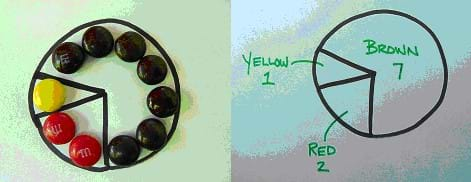
- Label each section with the color and number of M&Ms (see Figure 3).
- Write the fraction that represents each "pie piece" (the number of each color of M&Ms divided by the total number of M&Ms).
- List the fractions from largest to smallest. (Answer: 7/10, 2/10, 1/10)
- Tell the students that the brown M&Ms represent nitrogen (N2) at 78%, the red ones represent oxygen (O2) at 21%, and the yellow ones represent argon (Ar) at 0.9%. Some other elements also exist in the air that are too small for the pie chart. They include neon (Ne), helium (He), methane (CH4), krypton (Kr), hydrogen (H2), nitrous oxide (N2O), xenon (Xe) and carbon dioxide (CO2). These gases make up the remaining 0.1%. See Figure 2 or the attached Air Composition Pie Chart Worksheet.
- Next, tell students they are going to make a new graph representing the air outside of a power plant. Ask them if they think this air is safe to breathe.
- Arrange 5 brown, 1 red and 4 yellow M&Ms in a circle on a blank sheet of paper, with like colors together and the sides of the M&Ms touching.
- Trace around the circle. Estimate the center of the circle and mark it with your pencil.
- Draw a line from the center of the circle to the points at which the colors change on the circle of M&Ms (you should draw three lines).
- Label each section with the color and number of M&Ms.
- Write the fraction that represents each "pie piece" (the number of each color of M&Ms divided by the total number of M&Ms).
- Have the students compare these "air readings" to the normal (or base) conditions and decide whether or not they think the air is polluted. (Answer: This air has been polluted; it has more yellow M&Ms [carbon dioxide, methane, etc.] and fewer red M&Ms [oxygen]. People need oxygen to breathe and because less oxygen is in the air around this power plant, more effort should be made to reduce the amount of pollutants the plant releases into the air.)
- (optional) To make the activity more challenging, have two students combine their colors and repeat the activity, this time with 20 M&Ms, making a bigger circle. Now the fractions are 2/20, 4/20 and 14/20. Make the connections to equivalent fractions. Can two more groups combine? Can the entire class combine?
- Eat and enjoy the M&Ms.
Assessment
Pre-Activity Assessment
Pre-Quiz: Administer the How Much? Pre/Post Quiz. Note that two blank quizzes are provided per sheet (cut them apart). Review students' answers to gauge their base knowledge about the proportions of various gases in air. If students are not very familiar with the gas components and their percentages, tell them they will find out more in this activity. Administer the same quiz at activity end.
Activity Embedded Assessment
Brainstorming: In small groups, have students engage in open discussion. Remind students that in this forum, no idea or suggestion is "silly." All ideas should be respectfully heard. Encourage wild ideas and discourage criticism of ideas. Have students think of something else for which they may be able to use a circle graph (pie chart). Possible ideas include: age/height/weight/gender/eye color of students in class or the number of students in each grade. Then, have students create new charts (with or without M&Ms).
Post-Activity Assessment
Discussion Question: Ask the students and discuss as a class:
- Describe why the air composition pie chart information would be important to engineers working with air pollution. (Answer: Environmental engineers are often responsible for reducing air pollution created by the emissions from factories and power plants. Knowing the natural (unpolluted) composition of air gives them baseline information with which to compare factory emissions. Then, they can design ways to adjust the composition of emissions, which often have high levels of carbon dioxide and particulates, resemble that of unpolluted air.)
Post-Quiz: At activity end, administer the How Much? Pre/Post Quiz again. Compare students' answers to their pre-quiz answers to gauge their changes in content knowledge.
Safety Issues
- M&Ms, even the plain ones, contain peanut oil. Before doing this activity, check to see if any student has a peanut allergy. If so, you may want to use another multi-color, small candy such as Skittles®.
Troubleshooting Tips
- Make sure all students are using the same colors for each of the air components. This facilitates understanding in classroom discussions and decreases confusion when referring to air components by color.
- In the activity, some of the percentages are loosely rounded for purposes of simplification. Depending on your students, you may want them to be more precise in mapping their candy proportions and pie charts to the percentages of gas composition in air.
Activity Extensions
Give students a data table expressing the percentage composition of the atmosphere and have them create a graph with their M&Ms that represents the data. Challenge them to make more than one type of graph (bar, circle, etc.).
Research the atmospheric compositions of other planets. Create M&M circle graphs to represent the other atmospheres.
Demonstrate the composition of air with a jar of marbles. Use 10 marbles, 7 of one color (representing nitrogen), 2 a contrasting color (representing oxygen), and 1 a third color (representing argon).
Activity Scaling
For younger students in grades 1-2:
- Consider providing students with blank pie chart circle outlines (see Figure 3) and have them place M&Ms in them to match.
- Focus on the size of each fraction, for example, 7/10 M&Ms are more than 1/10.
- Have students make a third circle with 4 brown, 4 red, 4 yellow and 4 green M&Ms to demonstrate the fractions 4/16 (1/4), 8/16 (1/2), 12/16 (3/4).
For younger students in grades 3-4:
- Assign students to complete the Air Composition Pie Chart Worksheet
- Convert their fractions into decimal notation.
- List from largest to smallest the six fractions 7/10, 14/20, 2/10, 4/20, 1/10, 2/20.
- Find the fraction of nitrogen + oxygen, nitrogen + argon, and oxygen + argon.
For older students:
- Add up the actual values for nitrogen (N2) 78%, oxygen (O2) 21%, and argon (Ar) 0.9% to see that they only add up to 99.9%.
- [Extension Activity] Explain why the fractions in the small circle (7/10, 2/10, 1/10) are equal to those in the big circle (14/20, 4/20, 2/20).
- Add fractions in various combinations using 7/10, 2/10, 1/10, 14/20, 4/20, 2/20.
Note: This may be confusing to students since they will have 7/10 in the small circle, yet when they make a bigger circle they will have 14/20. Students may incorrectly assume that 7/10 + 7/10 = 14/20. If you try this activity, you may want to use different colors for the big circle so that the browns are associated with 1/10 (seven of them), while the blues (for example) are associated with 1/20 (14 of them).
- To incorporate larger fractions for older students, use regular M&Ms and mini M&Ms to more accurately represent the percentage of gasses in the air. Each large M&M represents 10% and each mini M&M represents 1% of the gasses in the air. The brown (78/100), red (21/100), and yellow (1/100) give a more accurate representation of the gas composition in the air. Each student will need 1 mini yellow M&M, 2 regular and 1 mini red M&Ms, and 7 regular and 8 mini M&Ms.

M&M pie charts representing the composition of air with larger fractions.
Subscribe
Get the inside scoop on all things TeachEngineering such as new site features, curriculum updates, video releases, and more by signing up for our newsletter!More Curriculum Like This

Students are introduced to the concept of energy cycles by learning about the carbon cycle. They learn how carbon atoms travel through the geological (ancient) carbon cycle and the biological/physical carbon cycle.

Students are introduced to the concepts of air pollution, air quality, and climate change. The three lesson parts (including the associated activities) focus on the prerequisites for understanding air pollution. First, students use M&M® candies to create pie graphs that express their understanding o...

Students learn the basics about the structure of the Earth’s atmosphere, the types of pollutants that are present in the atmosphere (primary, secondary, gas-phase compounds, particulate matter), and the importance of air quality research. They are also introduced to some engineering concepts such as...
References
EEK! What is ozone? Hole in the ozone layer? Environmental Education for Kids, Wisconsin Department of Natural Resources. Accessed July 19, 2004. https://www.eekwi.org/engage/outdoor-safety/what-ozone
Gaseous Composition of Dry Air, Table 3.1. ENS 23: The Physical and Chemical Environment, Spring 2005, University of California-Santa Cruz. Accessed September 13, 2006. Formerly available at: http://eesc.columbia.edu/courses/ees/slides/climate/table_1.html
Kalman, Bobbie and Janine Schaub. The Air I Breathe. New York, NY: Crabtree Publishing Company, 1993.
Copyright
© 2004 by Regents of the University of Colorado.Contributors
Amy Kolenbrander; Daria Kotys-Schwartz; Janet Yowell; Natalie Mach; Malinda Schaefer Zarske; Denise W. CarlsonSupporting Program
Integrated Teaching and Learning Program, College of Engineering, University of Colorado BoulderAcknowledgements
The contents of this digital library curriculum were developed under grants from the Fund for the Improvement of Postsecondary Education (FIPSE), U.S. Department of Education and the National Science Foundation (GK-12 grant no. 0338326). However, these contents do not necessarily represent the policies of the Department of Education or National Science Foundation, and you should not assume endorsement by the federal government.
Last modified: May 24, 2021








User Comments & Tips